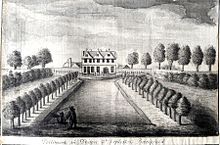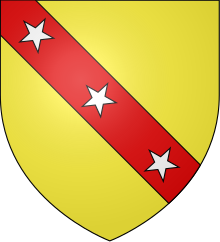Poltimore House

Poltimore House is a country house in the village of Poltimore in the English county of Devon . From the 13th to the 20th century , the manor of Poltimore was the seat of the Bampfylde family , who were elevated to Barons Poltimore in 1831 . The 18th century house contains many parts of previous houses that were built by the family on the property. English Heritage has it as a historical building II *. Grade listed.
In the second half of the 20th century, Poltimore House fell into disrepair. A group of enthusiastic volunteers began raising money to restore the house in 2003 after the project took second place on the BBC television series Restoration .
history
Acquisition by the Bampfyldes
The family Bampfylde was the manorial Poltimore 1298 by William Pontyngton , a canon of the Cathedral of Exeter , bequeathed. There are no records of where the first mansion stood, but it is believed to be in or near the village. There is no evidence that any previous house stood on the same site as the present one. Poltimore House was built on the orders of Richard Bampfylde († 1595). Work on it began in 1550.
There is no record of when the house was completed, but when Richard Bampfylde died in 1595, he bequeathed it to his son, Amyas Bampfylde († 1626). Since Richard was named High Sheriff of Devon in 1576 , it is likely that his stately home was already ready by then. Two wings of this old house can still be seen today as parts of the current building. It is not known what shape the old house originally had, whether it was just these two wings that form an L, or whether there was a third or even a fourth wing with a courtyard in the middle. Later family members had the existing house built; the last major additions were made in 1908.
Sold by the Bampfyldes
The Bampfyldes lived in the house until 1920 and then offered it for sale, including the land and property. The property was sold, but not the house and land, which were leased to Poltimore College , a girls' school. This was closed in 1939. In 1940 the boys from Dover College were evacuated here. The house became a private hospital in 1945, which was taken over by the National Health Service in 1948 immediately after the establishment of the National Health Service . In 1974 the hospital was closed.
Decay
Poltimore House passed through the hands of different owners until an arson attack in 1987 and has been vacant ever since. Theft and vandalism contributed to further deterioration.
restoration
In 2000 the Poltimore House Trust was founded to find a use for the house and to restore it. The first phase of the restoration consisted of erecting scaffolding with a protective roof and was carried out in 2005. In 2009 the Trust raised £ 500,000 from English Heritage so the actual restoration could begin.
More plans
The Poltimore House Trust released their 10-year plan for further restoration in 2009. There it is stated that Poltimore House should fulfill the following purposes in 2019:
- an exhibition for arts and crafts: a place for the arts, crafts, media designers, filmmakers and software developers.
- a home for creative entrepreneurs: highly specialized workplaces, hot desking and studios with excellent communication options .
- the Poltimore Forum: high level lectures, workshops and training events designed to bring leading thinkers to the south west of England.
- the club in Poltimore House: a meeting place for the region with well-equipped meeting rooms for briefings , networking and research.
- intensive innovations: exhibition about the new way of thinking, teaching and teaching: a combination of academy, tradition, industry, technology and the arts.
- a completely different day out: Poltimore House aims to attract visitors looking for inspiration, lessons, networking, relaxation and fun.
This range of projects is designed to bring Poltimore House and its property back to use as a vital resource for local and regional business, the arts and society.
Public access
The non-profit "Friends of Poltimore House" grant public access to the house at the times published on their website.
Non-profit associations involved in the restoration work
- "Friends of Poltimore House", Poltimore House, Poltimore, Exeter, EX4 0AU. Email: [email protected]
- "Poltimore House Trust", Poltimore House, Poltimore, Exeter, EX4 0AU. Email: [email protected]
Individual evidence
- ^ Poltimore restoration to go ahead . In: BBC News . September 15, 2003. Retrieved November 9, 2015.
- ↑ Jocelyn Hemming: A Devon House: The Story of Poltimore . University of Plymouth Press, Plymouth 2005. ISBN 978-1-84150-935-8 .
literature
- Jocelyn Hemming: A Devon House: The Story of Poltimore . University of Plymouth, Plymouth 2005. ISBN 978-1-84150-935-8 .
- Jocelyn Fortescue-Foulkes: From Celtic Settlement to 20th Century Hospital. The Story of Poltimore House . 1971.
- Archaeological Journal . Issue 31 (June 1874). Pp. 89-103: Bampfylde House, Exeter
- Thomas Wotton: The English Baronetage . Volume 1. London 1771. pp. 374-381: Bampflyde of Poltimore .
Web links
- Poltimore House . Images of England. Historic England.
- Poltimore House website
- Restoration - Saving Devon's Heritage . BBC Home.
Coordinates: 50 ° 45 ′ 28.6 " N , 3 ° 27 ′ 53.7" W.



